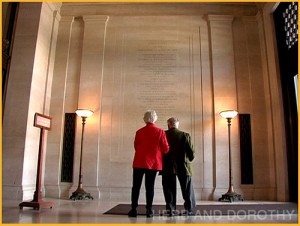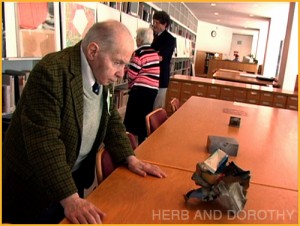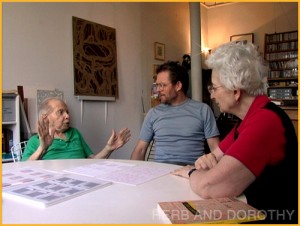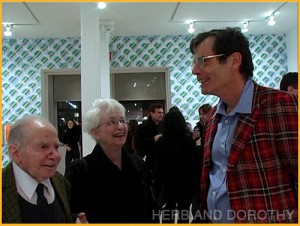Two art movies I saw this weekend have very little in common except for their smart storytelling and their reverence for art, artists and, in the case of Herb and Dorothy, art collectors. Both movies are great and here’s my take on the documentary about the amazing art collectors, the Vogels. I’ll tell you about Seraphine, a movie about a 19th Century self-taught cleaning lady, in another post.
You will not spend a sweeter 89 minutes this summer than in the company of Herb and Dorothy. The story of the postal worker and his wife, the reference librarian, who quietly and rapaciously amassed close to 5,000 works of art then gave it all away to the National Gallery of Art and other institutions shows you, without hitting you over the head, how good guys sometimes do finish first.

In addition to being wildly obsessive, generous, warm and witty, Herb and Dorothy are adorable. They were darling children, made a handsome young couple when they married in 1960, and, as seen through the change in Dorothy’s hairdo and glasses through the years, they were consummate hipsters in the flow of the New York art world.
The movie interweaves shots of the two of them in their cramped apartment with shots of them buying from artists like Richard Tuttle, Lynda Benglis and James Siena in the artist’s studios (their preferred method of doing business). There are scenes at gallery openings and shots of them strolling the National Gallery to see their art installed in its new home. Many artists they collected appear in the film to sing the collectors’ praises and tell tales. Lawrence Weiner and his biblical-length grey beard tell of making a piece for the Vogel’s bathroom, the only available wall in the apartment for a new work. Lynda Benglis tells of how persistent they were in their collecting. “They were greedy, really greedy…thank God they were greedy,” Benglis laughs. Here’s the trailer for the movie, with artists Christo and Jeanne-Claude, Weiner, Chuck Close and Benglis speaking about the collectors.

Greedy in a good way, the Vogels also pursued their artists for their friendship. More than one artist talked about this and several referred to the weekly phone calls they had from Herb on Saturday or Sundays just to catch up and talk art. “We have no children unfortunately but we have the art — and our animals” says Dorothy at one point. Cats run around the apartment and turtles and fish crawl and swim in big watery tanks. Richard Tuttle, seen in his studio at one point with a small dog on his lap, says of the collectors, “They have a very strong relationship to animals and I think there’s a strong relationship between art and animals.” He doesn’t explicate but clearly he and the Vogels all bonded with each other, their animals and Tuttle’s art, which they collected very heavily.
The precarious ecosystem in the Vogel’s apartment caused the National Gallery curator to seize up when he experienced it as he realized how much he needed to get the works out of the piles and piles in the apartment and into a better storage situation in the museum. When it finally happened, it took 5 large moving vans to move all the art to DC! First job, inventory-ing, something the Vogels had not done — 4,782 works in all!

Two small people endowed with “aesthetic eyes” and a love of some of the art world’s hardest art–conceptual and minimal–Herb and Dorothy started out as “artist wannabe’s,” says Dorothy. Explaining how they got focused on the difficult art, Dorothy says they were priced out of the pop art and abstract expressionist market when they started to buy and so they bought what they could afford, and, happily there was little competition for the tough work at the time.
Throughout the movie, the couple seems to dress in complementary colors or patterns–green and violet, for example, or stripes and checks. It’s a small touch and who knows whether it was planned but it re-inforces the fact that they are visual people who consider colors and patterns important in their lives.
The couple say they miss their art now that it’s at the NGA but that they go visit it a couple times a year. As for collecting, apparently they’re still at it. “It’s fun,” says Dorothy. “When it’s not fun we’ll stop.” The last scene in the movie shows the two of them in a Manhattan computer store. Dorothy is getting a Mac laptop (their first computer) and Herb is off looking at the fish in the fish tank.

Not only is this movie a “how to” for beginning collectors but it’s a “how to” for artists. Someone in the movie says there were artists who felt Herb and Dorothy were ripping them off and so they wouldn’t deal with them. Others, like Benglis, Tuttle, Siena, Christo and Jeanne-Claude, Chuck Close, Sol Lewit, Robert Mangold, Robert Barry, became friends with the collectors and worked with them on payment plans so their work would enter their collection. In fact it was a gamble for both sides but one that paid off. Dorothy says the artists were generous with them and she’s right. But they were generous with the artists and helped promote their works through the collection exhibits and press they’ve gotten through the years (including an early show of their works at Philadelphia’s ICA!).
Directed by first-time filmmaker Megumi Sasaki, Herb and Dorothy has a breezy, upbeat quality that counters but doesn’t the repeated and poignant scenes of the couple, now aging poorly, with Herb especially looking unwell and withdrawn. Like other documentaries without a narrator, this one has a point of view. It’s an 89-minute love-fest. It’s only here this week, so catch it quick.
Ritz at the Bourse, Philadelphia
(1:15, 3:15) 5:15, 7:20, 9:35PM
tickets





